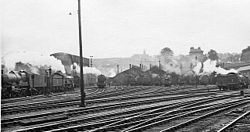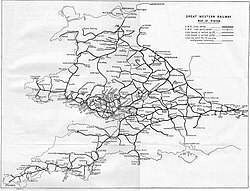
Bristol Temple Meads is the oldest and largest railway station in Bristol, England. It is located 118 miles 31 chains away from London Paddington. It is an important transport hub for public transport in the city; there are bus services to many parts of the city and surrounding districts, with a ferry to the city centre. It is the busiest station in South West England. Bristol's other major station, Bristol Parkway, is a more recent station on the northern outskirts of the conurbation.

Didcot Railway Centre is a railway museum and preservation engineering site in Didcot, Oxfordshire, England. The site was formerly a Great Western Railway engine shed and locomotive stabling point.

A motive power depot (MPD) or locomotive depot, or traction maintenance depot (TMD), is where locomotives are usually housed, repaired and maintained. They were originally known as "running sheds", "engine sheds" or just "sheds". Facilities are provided for refuelling and the replenishing of water, lubricating oil and grease and, for steam engines, the disposal of ash. There are often workshops for day-to-day repairs and maintenance, but locomotive building and major overhauls are usually carried out at locomotive works.
Wolverhampton railway works was in the city of Wolverhampton in the county of Staffordshire, England. It was almost due north of the city centre, and is commemorated with a small display of level crossing gates and a plaque. Known as the Stafford Road Works, it was opened by the Shrewsbury and Birmingham Railway in 1849 to maintain bought-in locomotives.

British Rail Class D3/10 was a single experimental diesel-electric shunter locomotive commissioned by the Great Western Railway (GWR) in England, and later taken over by British Railways.

St Blazey engine shed is located in Par, Cornwall, United Kingdom, although it is named after the adjacent village of St Blazey. It was built in 1874 as the headquarters of the Cornwall Minerals Railway but for many years was a depot of the Great Western Railway. The current depot operator is DB Cargo and the depot TOPS code is BZ.

Birkenhead Mollington Street was a former traction maintenance depot located at Mollington Street in Birkenhead, England, on the Birkenhead Dock Branch railway. Although never directly connected by rail, the depot was situated less than 200 m (660 ft) from Birkenhead Central railway station. The depot serviced steam and subsequently diesel locomotives until 1985, when it was closed and demolished. As of 2018, the site of the depot is still disused.

Old Oak Common TMD was a traction maintenance depot located west of London Paddington, in Old Oak Common. The depot codes were OC for the diesel depot and OO for the carriage shed. In steam days the shed code was 81A.

Laira Traction and Rolling Stock Maintenance Depot is a railway traction maintenance depot situated in Plymouth, Devon, England. The depot is operated by Great Western Railway (GWR) and is where their fleet of Class 802 InterCity Express Trains and remaining Castle Class trains are overhauled. Other trains visit for daily servicing including some operated by CrossCountry.
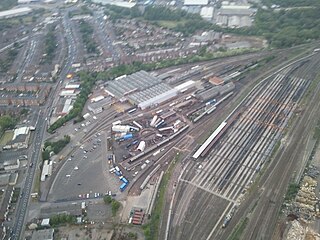
Tyseley TMD is a railway traction maintenance depot situated in Tyseley, Birmingham, England.
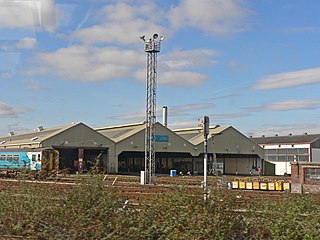
Cardiff Canton TMD is a diesel locomotive traction maintenance depot in Cardiff, Wales. Its depot code is CF. It is operated by Transport for Wales. The depot is used by Transport for Wales fleet and some Cross Country Class 170s.

Penzance TMD, also known as Long Rock TMD, is a railway traction maintenance depot situated in the village of Long Rock east of Penzance, Cornwall, England, and is the most westerly and southerly rail depot in the country. The depot operator is Great Western Railway. The depot code is PZ.

Exeter Traction Maintenance Depot is a railway Traction Maintenance Depot situated in Exeter, Devon, United Kingdom and is next to the city's main St Davids station. The depot is operated by Great Western Railway and has an allocation of diesel multiple units.

Shrewsbury TMD is a railway traction maintenance depot (TMD) situated in Coleham, Shrewsbury, England. The TMD forms part of Coleham Depot, a permanent way depot operated by Network Rail. The code for the TMD is 'SB'.
There were a number of engine sheds and railway works located in York. The large York North engine shed became the National Railway Museum in 1975.

St Philip's Marsh depot is a railway depot located in the St Philip's Marsh district of Bristol, England. It was established as a steam locomotive shed in 1910 but this facility closed in the 1960s. A new diesel facility opened nearby at Marsh Junction in 1959. This has since been combined with a new shed which was opened in 1976 to maintain new InterCity 125 trainsets.
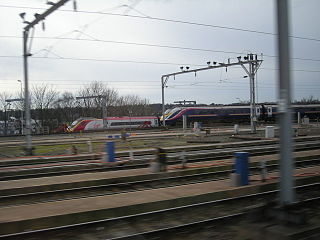
Oxley Traction and Rolling Stock Maintenance Depot is a railway depot located in Wolverhampton, West Midlands, operated by Alstom to maintain Avanti West Coast's British Rail Class 390 Pendolino stock for the West Coast Main Line.

Stewarts Lane is a large railway-servicing facility in Battersea in London, England, founded by the London, Chatham and Dover Railway (LCDR) in 1862, to serve London Victoria railway station. It is sited in the midst of a maze of railway lines between 'Factory Junction' and 'Stewarts Lane Junction', adjacent to the site of the former Longhedge Railway Works and the Stewarts Lane Chord formerly used by Eurostar trains from the Kent freight lines to Waterloo International station. Prior to 1962 it was one of the largest motive power depots in the UK. Following the end of steam traction in the early 1960s it was converted into a traction maintenance depot which is currently operated by Govia Thameslink Railway.

Ilford Depot is a traction maintenance depot located in Ilford, Greater London, England. The site is used for train stabling and maintenance by Greater Anglia, Elizabeth line, London Overground and Alstom.
Southport MPD (Motive Power Depot) is a former LMS railway depot located in the town of Southport, Merseyside.


